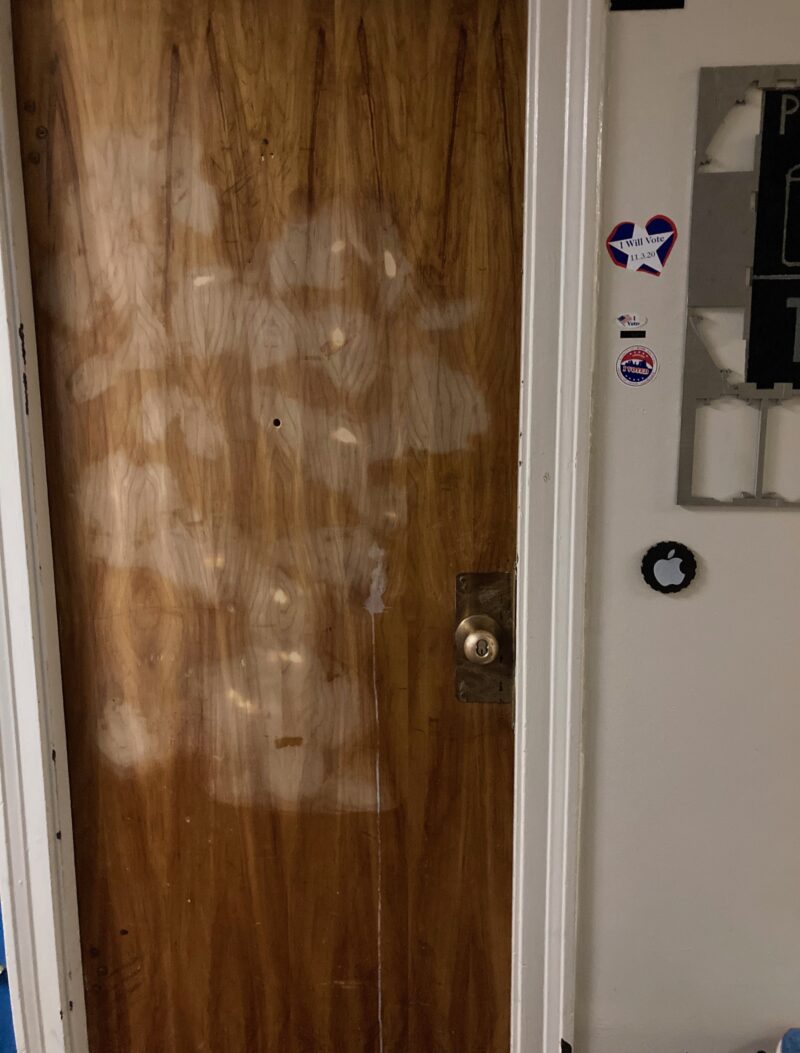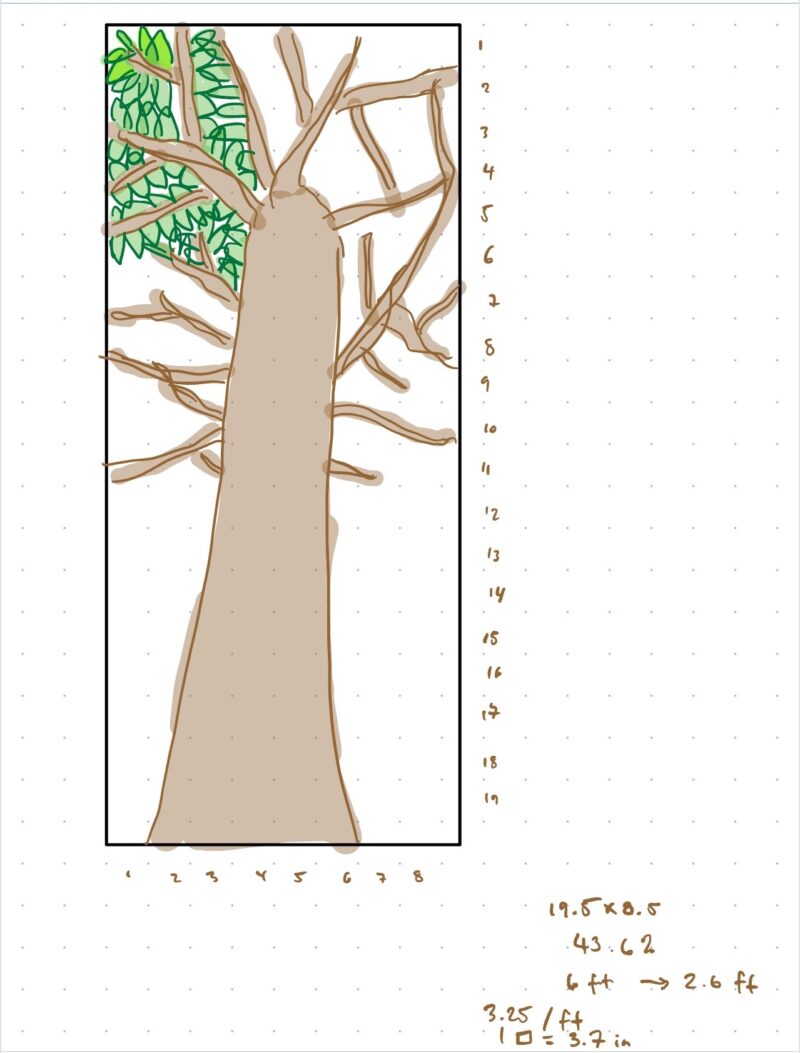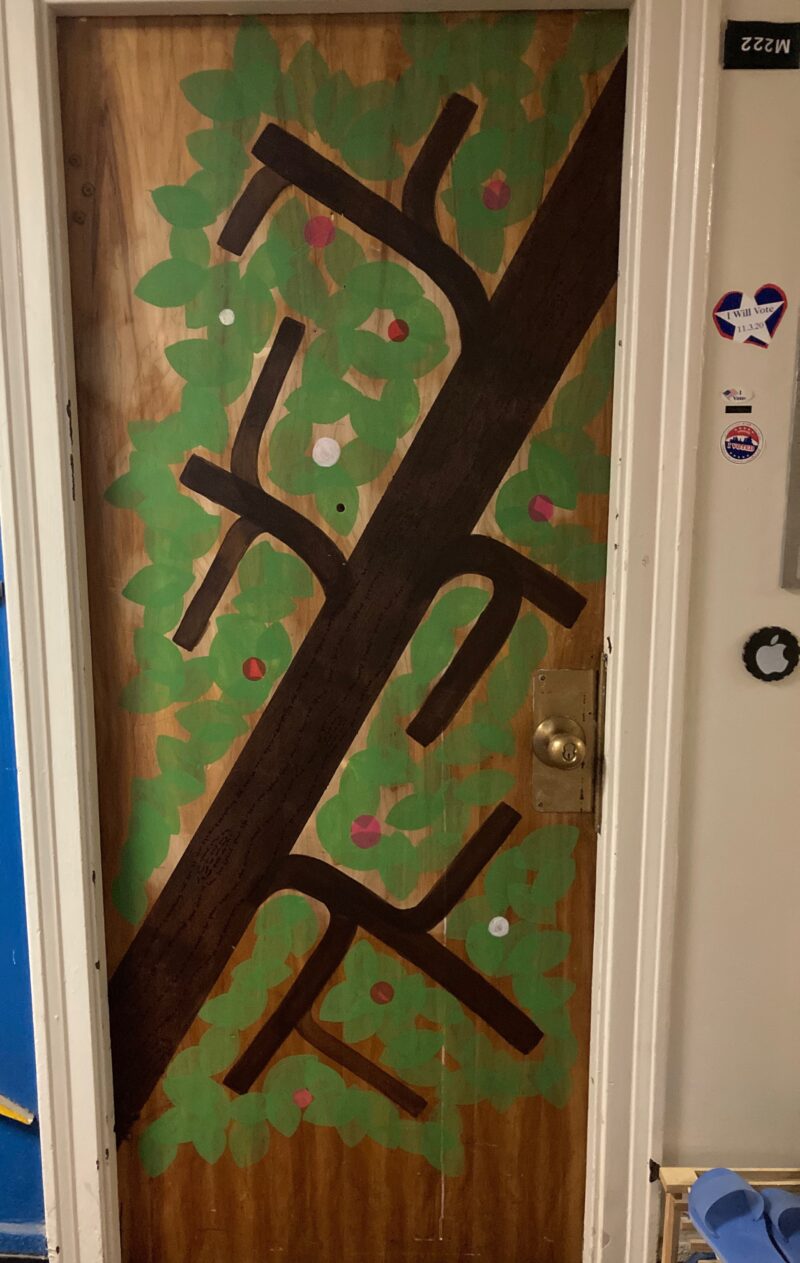
I painted my door! by Shuli J. '22, MEng '23
and it only took 2.5 years
In my dorm, East Campus, residents are allowed to paint the door to their room. Unlike murals on the walls, which generally have to be approved by the hall (or at least not objected to), your door is your own to do with as you like. Most doors have been painted and painted over who knows how many times, and each one has a story, whether it’s that of the current resident or someone from years ago.
But when I moved into my room at the start of my sophomore year, the door was not only blank, it was raw, unpainted wood. I immediately resolved to paint it. I wanted what I put on it to be special, to reflect the fact that it was the first time the door had ever been painted. I thought about it on and off for all the fall semester, and sometime late in IAP, I hit on the idea of a translucent tree: the paint showing the wood behind it, the door’s real wood grain becoming the grain of the tree. The semester got going before I could get painting, so I resolved to paint the tree over spring break. Then… one week before spring break, the Exodus occurred. So there was no door painting for me that year. Or the next. This blog post is the story of how my door finally got painted!
When I moved back into EC this fall, my senior fall, two full years later, I moved back into the same room. Time had only strengthened my resolve to paint my door. But there was a lot going on, because there’s always a lot going on. So I didn’t get started until winter break.
My zeroth step was to clean my door. Even though it had never been painted, it had sure been stickered, nailed, dripped on, etc. I did my very best to remove the evidence of all of these activities, and I did make a lot of progress, but a lot of it was unremovable. I decided this was OK – I liked the idea that underneath what I did to my door, you would always be able to see what other people did to it when it was their door.
My first step was to make some sketches on my
iPad.01
During the pandemic, MIT loaned iPads to all the undergrads so that we could use them to complete psets and exams remotely. They were also super fun for drawing on!
I knew approximately what I wanted: a tree whose transparent bark showed the wood grain, and whose transparent leaves looked like sunlight was coming through them. But I don’t have a lot of artistic talent experience (growth mindset!) and I needed to figure out a way to represent this that would look good with my limited abilities. After some trial and error, I settled on a geometric representation of a tree. Drawing real objects accurately is very difficult, but drawing straight lines is much easier. (Note that I did not say it is easy.)
With a plan in place, I resolved to finish my door by the end of IAP. And, well… I did at least start it! I walked to Central Square and bought the paint at Blick’s art store, a sentence which hides a significant amount of deliberation over the like seven kinds of acrylic paint you can buy at Blick’s. I decided to go with a middle of the road paint brand, not the cheapest but not even close to the nicest. I bought four colors: two shades of green, light and dark so I could mix them for the leaves, and brown and black so I could mix them for the trunk.
The next step was to try out some color mixing. I also had to mix in water to make the paint transparent, so that added another degree of freedom. I tested out some options on the back of my door — mostly because I needed to know how they would look on actual treated wood, but I also liked the idea of future residents of my room being able to see my planning. So often, when you move into a room with a painted door, you know little or nothing about the story behind it; my tester leaves are like a tiny little clue to the process and desires that created my door.
Once I had my ratios the way I liked them, I was ready to start with the door! For the main part of the trunk, the lines were long enough that I put down painter’s tape. This was a super finicky process, though, and I didn’t want to repeat it ten more times, so I freehanded the rest of the branches. You can definitely tell, but they still look OK. Although in an ideal world they would’ve looked nicer, I think this is good enough for the level of effort and time I had available. I also wish that in general, they had come out a bit more transparent. After the main trunk came out darker than I thought it would be, I tried to make each subsequent size of branch a little more transparent as a kind of fade-out, but I’m not sure how noticeable that ended up being.
Next, I started the leaves. Because there were going to be so many of them, and because I wanted them all to look very similar to fit the geometric style I was going for, I made stencils. I made two, a big one and a small one.
And then, uh, IAP ended and I didn’t do anything for a really long time because getting stuff done during the semester is hard. But as the semester wound down, I finally found time to start painting the leaves! I overlapped them, just as I had in the plan, with the goal of having the overlapping areas show up darker (just like real leaves do!). Although that didn’t work with every single overlap area, it worked with enough of them that I think you do get the overall effect I was going for.
Right when I thought I was done, I had an idea that wasn’t in my plan. At around the same time I was finishing up the leaves, it finally became spring on campus (something that never seems to happen until halfway into May, instead of March or April like you hope). And spring brought a proliferation of flowers!
When I saw the trees blossoming, I immediately knew I wanted to paint flowers on my tree as well. I liked the idea of creating a permanent reminder of such a beautiful but fleeting time on campus. I also liked the idea that future students might see my door from September through April and wonder what was going on with the flowers (especially since they’re so geometric that it’s not obvious what they are), until finally right at the end of the year it would all make sense, like a little secret in plain sight.
Once all the painting was done, it was time for the very last step. When I was iterating through sketches at the very beginning I wasn’t sure if I wanted to put wood grain lines on my tree trunk — would it be overkill, would it look weird, would it be the perfect finishing touch? While I was cleaning all the stickers off the door, and coming to terms with the ones that remained, a phrase popped into my head: everything old can be new again. As soon as I thought of it, I knew that I wanted words to be the wood grain of my tree. All throughout working on this project, I collected words. Sharpie-ing them onto the trunk was the last step to completing the door.
Here’s the words that make up each line:
- everything old can be new again. Inspired by the door itself, which was a tree, then wood, and is now both; and whose layers of wear and tear are not hidden, but visible for everyone to see.
- how you spend your days is how you spend your life. Inspired by my desire to spend more time in the way I did on this project, making art just because I wanted to.
- you are everyone you’ve ever been. Also somewhat inspired by the door’s wear and tear, but also by the important-to-me realization I had during the semester I painted it.
- for your sake was the world created / you are but dust and ashes. This comes from a Jewish saying; the idea is that you should think of each of these phrases at the time when they are needed (i.e. when you need either confidence or humility). I wrote this on my grad cap when I graduated high school, and I liked the idea of writing it again here, almost exactly four years later as I graduate college.
Overall, I’m happy with how my door came out. You can certainly tell I’m not the most experienced artist, but I almost like that — that you can look at this and think, a regular person made that just because they wanted to. I really enjoyed every step of the process: iterating on the idea to find the one that was just right; painting the door from the hallway and chatting with people who walked by; creating a brand-new idea from a messy mix of the canvas at hand, the environment around me, and my own brain.
East Campus is getting renovated at the end of the next academic year, so this door will only be around for one year. But even if it were gone tomorrow, I’m glad I made it. And in the twelve months it will be here, I hope it’ll pique someone’s curiosity or bring them joy when they walk by. :)
- During the pandemic, MIT loaned iPads to all the undergrads so that we could use them to complete psets and exams remotely. They were also super fun for drawing on! back to text ↑
